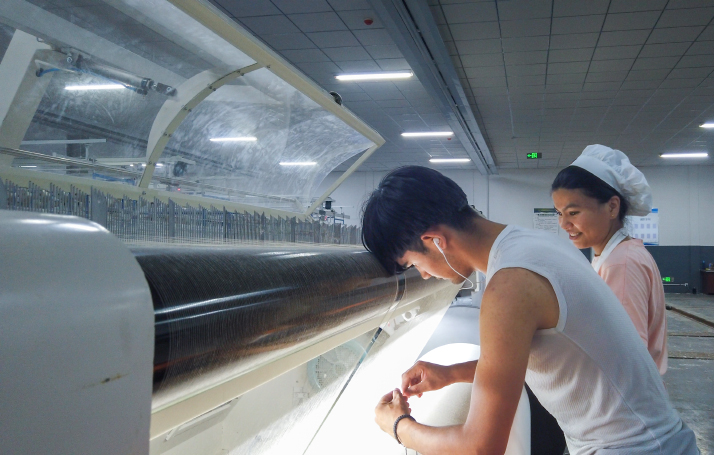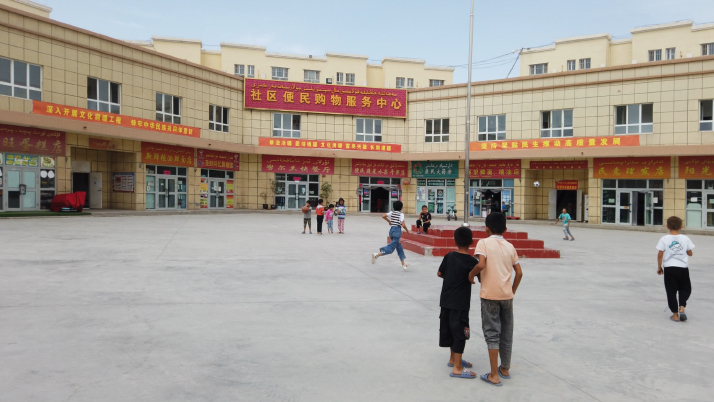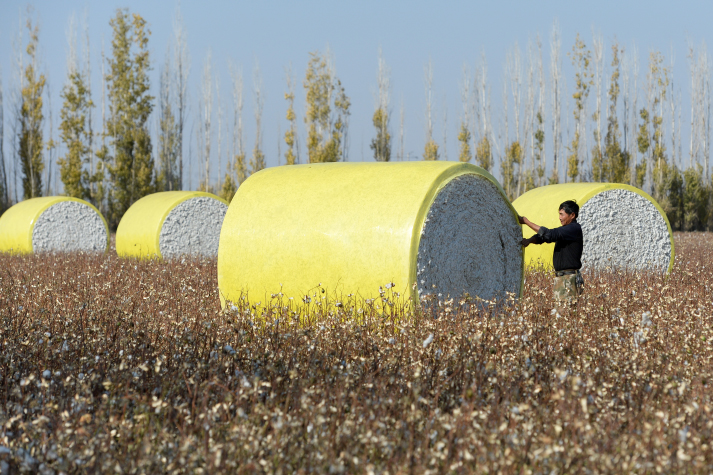
A mentor shows a new warping reel operator the ropes at a textile factory on July 31 in Bachu, a county in the southern part of Xinjiang Uygur Autonomous Region (LI FANGFANG)
Alim Molla, a 19-year-old Uygur man, likes to put on his headphones and listen to music when operating the warping reels at a textile factory in the county of Bachu, some 200 km east of Kashgar City in Xinjiang Uygur Autonomous Region. Before starting his job, he trained at a vocational school for four months.
Alim has outlined a career path for himself: mastering the warping process in school, working in a textile factory for one or two years to build up some savings, acquiring car-repair skills and then working as a mechanic for the rest of his life. If not for the multiple factories in the county, he probably would have followed in his parents' footsteps and become a farmer. But this land near the desert doesn't pay off, no matter how one toils away every day.
For now, his primary objective is to become economically independent. About 3,500 yuan ($519) a month, the average income of a textile worker in Kashgar, earns Alim a comfortable life in his new urban setting. He currently lives inside the textile industrial park where his factory locates, at an annual rent of about 120 yuan ($18)—as the rent is largely subsidized by the factory and local government.
Alim's neighbor Adila Rahman's family moved into the compound three years earlier, not as factory workers but as business owners. Adila's father Rahman Yasin runs a restaurant where the main patrons are workers residing both in and outside the compound.
"They usually come to my restaurant for lunch around 1:30 p.m. Eight yuan ($1.2) buys them a bowl of noodles," Rahman told Beijing Review. Noodles mixed with fried vegetables and mutton is a favorite dish among locals, over 90 percent of whom are of Uygur descent.
Rahman had lived the traditional life of a farmer in a village nearby before 2019, but what he stood to gain from only 1.3 hectares of land was far from enough to feed his family of six. The family's finances were further strained by the pressure to pay tuition for two daughters attending university in Urumqi, the regional capital. He moved into the factory's compound in 2019, diving straight into the food and beverage business.
Rahman is content knowing his family can now set aside a little money and leads a more comfortable life, but his daughter Adila has bigger plans. She wants to equip herself with all the possible knowledge and skills she can assemble on campus and to achieve this goal, she hopes to travel to other provinces for further education.
"But I still hope to return to Kashgar one day because that's where my family lives," Adila said.

Children play during the summer vacation on July 31 (LI FANGFANG)
After past bouts of violent separatism, Xinjiang has seen no terrorist incidents for nearly six years and today is earning back its reputation as one of China's top tourist destinations and an economic hub under the Belt and Road Initiative, proposed by China in 2013 to enhance development cooperation and connectivity among participants. Many fresh graduates or Xinjiang natives working in other provinces for years have now opted to return to their homes in China's westernmost region.
"It is promising to see more and more university students coming to Xinjiang," Yao Ning, Secretary of Bachu County Committee of the Communist Party of China, told Beijing Review. "A long-term career in a thriving economic environment will make them settle down; that's why we must develop the economy," he added.
With one dyeing company recently opening its first facility in the county, a whole cotton textile chain has been established here, from spinning and weaving to garment production. "We will keep upgrading our services for companies coming to this industrial park. And the next goal is to outperform those parks in the north [of Xinjiang]," Wang Jidong, a staff member of the industrial park, said.

A farmer checks the bundles of mechanically picked cotton in Manas County, Xinjiang Uygur Autonomous Region, on October 17, 2020 (XINHUA)
Cotton to Clothing
Blessed with long days, more intense sunlight, and an array of other natural conditions suitable for cotton growing, Xinjiang's cotton textile industry has not only developed into an economic pillar of the region, but also enriched local culture. Hundreds of thousands of people rely on the industry for income, generation after generation. Coming from a place that boasts quality cotton strikes a chord of local pride.
For 26 consecutive years, Xinjiang has ranked first in China in terms of cotton output and planting area. Cotton output in the region during the 2020-21 period was 5.2 million tons, accounting for about 87 percent of domestic output.
While China's total cotton output last year was about 5.95 million tons, its domestic demand amounted to roughly 7.8 million tons. Hence, a number of textile companies believe the domestic market alone is big enough for them to run a thriving business.
As China's main cotton production area, Xinjiang has long aspired to boost its textile industry. Its regional 12th Five-Year Plan (2011-15) made it clear that Xinjiang would vitalize its textile industry with the support of technological progress and by taking advantage of the opportunity presented by the transfer of the textile industry from China's middle and eastern provinces to its western regions.
Ten years on, cotton production and weaving have become more automated.
It's common to see unmanned tractors equipped with automatic planting systems that ensure high accuracy when planting in spring, and in summer drones spray insecticide on the cotton fields. In autumn, mechanical cotton pickers work both in the northern and southern areas of Xinjiang, which makes up one sixth of China's territory.
Mechanically picked cotton accounted for over 80 percent of the regional total in 2021.
The middle and lower reaches of the industry, too, have gotten up to speed in the past decade. From 2014 to 2020, the number of companies active in Xinjiang's textile industry increased from 560 to around 3,300, including 1,000 from eastern provinces. According to a 2018 Xinjiang textile industry development plan, by 2023, cotton spinning capacity will reach 20 million spindles, 250,000 tons of knitted fabrics and 800 million pieces of clothing.
Despite the boycott of Xinjiang cotton and textile products, introduced by the Donald Trump administration in January 2021 based on the false claim of the so-called "forced labor," has cast a shadow over Xinjiang's pillar industry, the region has emerged even stronger as its quality cotton and textile products remain popular in the domestic and global markets, Liu Yaozhong, Deputy Director General of the textile industry sub-council of the China Council for the Promotion of International Trade, told China Daily in November 2021.
"The textile industry in the middle and western regions has a promising future," said Sun Ruizhe, Chair of China National Textile and Apparel Council, during their mid-year meeting in August. "Its contribution to Xinjiang's development is one good example [thereof]."
Many Xinjiang locals, particularly those living near the Taklimakan Desert for generations on end, today have developed a taste for modernization after shaking off absolute poverty in late 2020.
When Guzalnur Turdi rides an electrical vehicle checking the machinery at a mill in Kashgar, all she can think about is that she has to work harder, improve herself and create better opportunities for her children. She was promoted to manager of the rotor spinning team a while back. And, as a mother, being able to work near home is what she cherishes most.
"I do enjoy the educational resources this city has to offer and I hope my children can keep learning and grow into knowledgeable adults. This is important for living a quality life," she said.
Source: https://www.bjreview.com/China/202208/t20220815_800303604.html